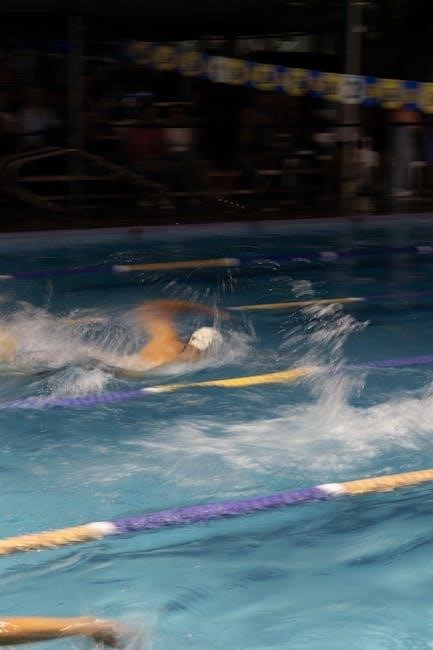The 17th edition of Principles of Athletic Training serves as a cornerstone for understanding evidence-based practices in sports medicine, integrating scientific knowledge with clinical expertise to optimize athlete care and performance.
Overview of the 17th Edition
The 17th edition of Principles of Athletic Training: A Guide to Evidence-Based Clinical Practice offers a comprehensive update on the latest advancements in athletic training. It provides a detailed exploration of evidence-based practices, covering essential topics such as injury prevention, assessment, treatment, and rehabilitation. Designed for both students and professionals, this edition emphasizes a competency-based approach, ensuring readers gain practical and theoretical knowledge. With its wide-ranging content, it serves as a vital resource for anyone involved in sports medicine, aligning with the evolving needs of the field. The guide is now accessible through subscription-based platforms like AccessPhysiotherapy.
Importance of Evidence-Based Clinical Practice
Evidence-based clinical practice is the cornerstone of modern athletic training, ensuring that interventions are grounded in scientific research. This approach minimizes reliance on anecdotal methods, enhancing patient outcomes and care quality. By integrating best practices, athletic trainers can address injuries more effectively, reduce recovery times, and improve overall athlete performance. The 17th edition emphasizes this methodology, providing practitioners with reliable, research-backed strategies to inform decision-making. This focus on evidence-based care not only elevates professional standards but also fosters trust between athletes and trainers, creating a more effective and efficient healthcare environment in sports medicine.

Key Features of the 17th Edition
The 17th edition offers updated content, enhanced injury prevention strategies, and comprehensive rehabilitation techniques. It also provides subscription-based access through AccessPhysiotherapy, ensuring evidence-based practices are readily available.
New and Updated Content
The 17th edition of Principles of Athletic Training introduces updated chapters on injury prevention, advanced assessment techniques, and modern rehabilitation methods. It incorporates the latest research and clinical practices, ensuring a comprehensive understanding of evidence-based care. New content focuses on emerging trends in sports medicine, such as personalized rehabilitation programs and innovative therapeutic approaches. The edition also includes expanded case studies and practical applications, making it a valuable resource for both students and professionals. Additionally, the guide now offers enhanced digital access through subscription-based platforms like AccessPhysiotherapy, providing convenient and reliable learning tools.
Enhanced Focus on Injury Prevention
The 17th edition emphasizes injury prevention through evidence-based strategies, offering practical guidelines to reduce athletic injuries. It explores risk factors, screening methods, and proactive measures to enhance athlete safety. The guide provides detailed protocols for common injuries, promoting early intervention and long-term health. By integrating the latest research, it equips professionals with tools to create safer training environments. This focus ensures that athletic trainers can implement effective prevention programs, minimizing downtime and optimizing performance. The edition’s comprehensive approach makes it a vital resource for fostering resilience and longevity in athletes.
Comprehensive Coverage of Rehabilitation Techniques

The 17th edition provides an extensive review of rehabilitation techniques, offering evidence-based strategies for restoring function and mobility. It includes detailed protocols for various injuries, emphasizing personalized approaches to meet individual needs. The guide covers the latest advancements in therapeutic exercises, manual therapy, and technology-driven recovery methods. By addressing the full spectrum of rehabilitation, from acute care to return-to-play protocols, it serves as an invaluable resource for athletic trainers and health professionals. This comprehensive coverage ensures that practitioners are equipped to design effective, tailored rehabilitation programs, promoting optimal recovery and performance.
Target Audience for the Guide
This guide is designed for athletic training students, professional trainers, and health science professionals. It provides foundational knowledge and practical insights, supporting education and real-world applications.

Athletic Training Students
Athletic training students benefit immensely from the 17th edition, as it provides a competency-based approach tailored to their educational needs. The guide covers foundational concepts, evidence-based practices, and clinical applications, preparing students for real-world challenges. With detailed chapters on injury prevention, assessment, and rehabilitation, it serves as a comprehensive resource for understanding the scientific and practical aspects of athletic training. The inclusion of updated content ensures students are well-versed in the latest advancements, making it an essential tool for their academic and professional development in the field.
Professional Athletic Trainers
Professional athletic trainers will find the 17th edition indispensable for staying current with evidence-based practices and advancing their clinical expertise. The guide provides in-depth insights into injury prevention, assessment, and rehabilitation, ensuring professionals can deliver optimal care. It also offers practical applications of the latest research, enabling trainers to refine their techniques and improve athlete outcomes. With its comprehensive coverage, the 17th edition supports professionals in maintaining high standards of practice and adapting to the evolving demands of sports medicine. It is a vital resource for enhancing professional development and staying at the forefront of the field.
Health Science Professionals
The 17th edition of Principles of Athletic Training is a valuable resource for health science professionals, offering evidence-based insights into sports medicine and rehabilitation. It bridges the gap between theoretical knowledge and practical application, making it essential for those working in related fields. The guide provides comprehensive coverage of injury prevention, assessment, and treatment, enabling health science professionals to integrate athletic training principles into their practice. Accessible via platforms like AccessPhysiotherapy, this edition ensures professionals stay updated on the latest advancements, supporting interdisciplinary collaboration and enhancing patient care in dynamic healthcare settings.
Core Principles of Athletic Training
The 17th edition emphasizes evidence-based practices, blending scientific foundations with clinical applications to ensure effective athlete care and optimal performance, reflecting the evolution of modern sports medicine.
Scientific Foundations of Athletic Training
The 17th edition delves into the scientific underpinnings of athletic training, covering biomechanics, exercise physiology, and sports psychology. It provides a robust framework for understanding human movement and injury mechanisms, ensuring trainers can apply evidence-based methods. The guide also explores the latest research in strength and conditioning, offering practical insights for enhancing athletic performance. By integrating these scientific principles, the edition equips professionals with the knowledge to address diverse training needs effectively, fostering a deeper understanding of the biological and mechanical aspects of sports medicine.
Clinical Applications in Sports Medicine
The 17th edition emphasizes the practical application of scientific principles in real-world sports medicine scenarios. It provides detailed insights into injury assessment, treatment protocols, and rehabilitation strategies. The guide covers acute care techniques, therapeutic exercises, and manual therapy methods, ensuring trainers can apply evidence-based practices effectively. By focusing on clinical applications, the edition bridges the gap between theoretical knowledge and hands-on patient care, making it an invaluable resource for both students and practicing professionals in the field of athletic training and sports medicine.
Injury Prevention and Assessment
The 17th edition provides comprehensive strategies for reducing athletic injuries and advanced techniques for assessing injuries, ensuring effective prevention and accurate diagnosis in sports medicine.
Strategies for Reducing Athletic Injuries
The 17th edition outlines evidence-based strategies to minimize athletic injuries, including tailored training programs, proper equipment use, and injury-specific prevention techniques. It emphasizes the importance of assessing individual risk factors and implementing personalized interventions. The guide also covers the role of strength and conditioning, flexibility exercises, and biomechanical analysis in reducing injury rates. By integrating these strategies, athletic trainers can create safer environments for athletes, promoting long-term health and performance. These methods are supported by the latest research and clinical practices in sports medicine.
Advanced Assessment Techniques
The 17th edition details advanced assessment techniques to accurately diagnose and manage athletic injuries. It covers comprehensive evaluations, including biomechanical analyses and functional movement assessments. These methods enable trainers to identify potential issues early, ensuring timely interventions. The guide also emphasizes the use of evidence-based tools and technology to enhance assessment accuracy. By mastering these techniques, professionals can develop personalized care plans, improving outcomes for athletes. This section is particularly valuable for students and practitioners seeking to refine their diagnostic skills in sports medicine.

Treatment and Rehabilitation

The 17th edition emphasizes evidence-based approaches to treatment and rehabilitation, integrating scientific knowledge with practical applications to restore optimal function and performance in athletes.
Current Trends in Athletic Therapy
Current trends in athletic therapy emphasize evidence-based, personalized approaches to rehabilitation, incorporating advanced technologies like wearable devices and AI-driven analytics. The 17th edition highlights the integration of mental health support into rehabilitation programs, recognizing the importance of psychological well-being in recovery. Additionally, there is a growing focus on preventive care and dynamic assessment tools to identify risks early. These innovations reflect the evolving nature of athletic training, ensuring therapies are tailored to individual needs and optimized for better outcomes. Access to such resources is now more accessible through platforms like AccessPhysiotherapy.
Personalized Rehabilitation Programs

Personalized rehabilitation programs are now a cornerstone of modern athletic training, focusing on tailored strategies to address individual needs and promote optimal recovery. The 17th edition emphasizes the importance of customizing therapies based on athlete-specific factors, such as injury type, fitness level, and goals. Advanced assessment tools and data-driven insights enable trainers to design targeted programs that enhance recovery timelines and reduce reinjury risks. These programs often integrate manual therapies, exercises, and technology, ensuring a holistic approach to rehabilitation. This shift toward personalization reflects the evolving understanding of human physiology and the demand for precise, effective care in sports medicine.
Evolution of Athletic Training Practices
The evolution of athletic training practices reflects a shift from traditional methods to evidence-based approaches, integrating scientific advancements and clinical expertise for enhanced athlete care.
Historical Development of the Field
Athletic training has evolved significantly since its inception in the early 20th century, transitioning from basic first aid to a sophisticated, evidence-based medical profession. The establishment of professional organizations, such as the National Athletic Trainers’ Association (NATA) in 1950, marked a turning point, promoting standardized practices and education. Over the decades, the field has integrated advancements in sports medicine, rehabilitation, and injury prevention, shifting from reactive care to proactive health management. This historical progression underscores the growing recognition of athletic training as a vital component of healthcare, emphasizing scientific rigor and clinical expertise.
Modern Advances in Training Methods
Modern athletic training has embraced cutting-edge technologies and methodologies, revolutionizing how professionals approach athlete care. The 17th edition highlights the integration of data analytics, wearable technology, and artificial intelligence to monitor performance and prevent injuries. Personalized training programs, incorporating genetic and biomechanical analysis, are now standard. Additionally, there is a growing emphasis on mental health and nutrition as integral components of holistic athlete development. These advancements reflect the profession’s commitment to staying at the forefront of scientific and clinical innovation, ensuring optimal outcomes for athletes across all levels of competition.

Accessing the 17th Edition
The 17th edition is available as a free PDF download or through subscription-based platforms like AccessPhysiotherapy, offering flexible access to its comprehensive athletic training resources.
Free PDF Download Options
The 17th edition of Principles of Athletic Training is available for download as a free PDF, offering convenient access to its comprehensive content. This option allows users to explore evidence-based practices, injury prevention strategies, and rehabilitation techniques without subscription requirements. The PDF format ensures portability, enabling athletic trainers and students to reference the guide on various devices. Verified sources provide a reliable download experience, making it an ideal choice for those seeking affordable access to cutting-edge athletic training knowledge. This free resource is particularly beneficial for students and professionals seeking to enhance their skills in sports medicine.

Subscription-Based Resources

Access to the 17th edition of Principles of Athletic Training is also available through subscription-based platforms like AccessPhysiotherapy. This resource, provided by McGraw Hill, offers a wealth of trusted content from leading experts in the field. Subscribers gain exclusive access to the full text, along with additional tools and updates; While free PDF downloads are an option, subscription-based resources provide a more comprehensive and enhanced learning experience. This platform is particularly useful for professionals and students seeking ongoing access to the latest advancements in athletic training and sports medicine.
The 17th edition of Principles of Athletic Training remains a cornerstone for advancing evidence-based practices in sports medicine, offering both free downloads and subscription-based access for comprehensive learning.
Impact of the 17th Edition on Athletic Training
The 17th edition of Principles of Athletic Training has significantly influenced the field by providing updated, evidence-based practices and resources. Its comprehensive coverage of injury prevention, assessment, and rehabilitation has set a new standard for athletic training education and practice. The availability of free PDF downloads and subscription-based access through platforms like AccessPhysiotherapy has made it more accessible to students and professionals. This edition not only enhances clinical decision-making but also supports the evolution of the profession, ensuring that athletic trainers are equipped with the latest knowledge and tools to improve athlete care and outcomes.
Future Directions in the Field
The 17th edition of Principles of Athletic Training highlights the evolving nature of the field, emphasizing the integration of advanced technologies and personalized approaches. Future directions likely include expanded use of data analytics for injury prevention, greater emphasis on mental health in athlete care, and further incorporation of interdisciplinary collaboration. The profession may also see a rise in specialized certifications and continuing education programs to address emerging trends. Access to digital resources like the free PDF and subscription-based platforms will continue to play a key role in disseminating knowledge and fostering innovation in athletic training practices globally.